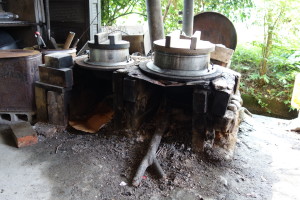Energy Transitions in Everyday Life
The final finding sheet on this theme can be found at the bottom of the page.
This strand lifts the lid on rising aggregate ‘demand’ in the twentieth century to investigate the dynamics of change and diverse worlds of energy use in everyday life. Transitions from wood and coal to coke, natural gas, electricity and oil varied immensely by country, region, class and building type. In post-war Britain, gas faced cultural as much as economic barriers. Salesman were turned away by consumers who held that gas heating was bad for ‘chesty’ people and ‘killed’ house plants. In 1960s Germany, electrical appliances sat beside coal briquette ovens. In Japan after 1973, families combined kerosene with electric heaters. We will look at how new fuels entered the home, or failed to do so. This involves reconstructing people’s values and practices, as well as how new energy and technologies were communicated and marketed.

While cleaner fuels made energy less visible, providers sought to give it a human face: the ‘King Coke’ cartoon in Britain; the ‘Strom’ and ‘e-Männchen’ [little electricity men] in Germany. Some writers praised the female character of electrical appliances. We ask how energy was made visible and gendered. Energy prices, too, had to be communicated. Tariffs could form a bewildering jungle – Weimar Germany had over 1,000 of them – and fuelled conflicts over fairness and entitlement. In 1974, Tsuruoka Co-op sued oil companies over the just price for kerosene, sparking a national consumer movement. We also ask about the changing place of the meter and how the meaning of energy changed with its measurement. In new blocks in 1950s Hamburg, meters were excluded from flats and hidden in basements. Monthly meter-readings switched to once a year. In the UK, the 1960s saw widespread complaints about ‘estimated’ energy use, and innovations in ‘tele-metering’.
Transitions from one fuel to another involved fascinating social experiments by cities and states, from modern show-houses and tower blocks to entire communities acting as guinea pigs for new technologies. Case studies in London, Burton-on-Trent, Saijo and Frankfurt will examine the visions underlying these mini-futures but also their quotidian reality. Transitions brought disruptions to cities and households, and debates about who should pay for them (consumer or provider; city or state; this generation or the next). In Frankfurt in 1956, the conversion to alternating current (AC) ground to a halt because of costs. Transitions to a new current or fuel meant converting household durables. We explore the day-to-day challenges of these conversions.
The cultural pathways for these transitions illuminate a neglected dimension of social life, but also have relevance today for those seeking to facilitate transitions towards cleaner fuels. The World Bank recently recognised culture as critical for the uptake of clean cooking stoves in the developing world. One case study will follow these campaigns in India since the 1970s, tracing the historical interaction between local women’s groups and international actors.
These micro-perspectives are crucial because standard accounts have tended towards a homogenous portrayal of technologies and their impact on domestic life. Reality was more complex, between rural and urban consumers, different generations, even within the same neighbourhood. In 1929 Römerstadt, Frankfurt, all had electric ovens, but energy use varied significantly by day and season between those with central heating and those reliant on a coal fire. On post-‘45 British estates, temperatures and comfort were highly uneven. Central heating was expensive and many poor tenants preferred their paraffin heater. In Germany, RWE in 1974 found strikingly different energy use patterns. In one neighbourhood, 42% cooked lunch, 49% also cooked dinner. 17% bathed once a week; 11% several times a day. Such research formed the basis for preparing for future predicted demand, which returns us to the theme of energy futures.
For more details, please see MCE Everyday Life Finding Sheet.
MORE RESEARCH THEMES
Energy grids are not uniform. They have uneven social and cultural consequences that have affected energy use over time. In this theme we explore how grid developers have envisaged consumers in relation to the spatial formation of grids. And we ask how such visions have been connected to emerging domestic arrangements and shifting temporalities of demand. Our case studies include hydro-electric developments in Canada and Britain. The arrival of networks was uneven in different regions connecting consumers to a variety of material resources and infrastructures. This research theme investigates the range of connections forged by the arrival of grids and how these supported divergent methods of heating, cooking and lighting. Electrified and other energized spaces are shown to be the products of distinctive socio-political regimes that have evolved together with variable and dynamic consumer roles, expectations and routines.
'Communicating Material Cultures of Energy' project is a one-year public engagement funded by the Arts and Humanities Research Council. The project explores various ways to improve the public communication of energy-related information and knowledge by bringing together 'energy communicators' across sectors and industries.
This toolkit takes stock of insights derived from contemporary communication practices, but it is also informed by recent research from the field of communication studies and the social science of energy. The five tools in this toolkit are designed to address core issues in energy communication. They are intended to be used as a set of adaptive methods to help communicators reflect on their communicative practices by using their own projects as examples. The exercises also offer somewhat unconventional methods through which to plan and review communication projects in order to reconsider the fundamental question of how to approach energy communication.
Throughout the twentieth century projected visions of future energy supply and demand have fluctuated between utopian and dystopian scenarios. Long before the 1973 oil crisis concerns over long-term energy shortages led national governments, international organizations, experts and consumers, to predict what an energy future ‘might’ look like. These forecasts reflected current anxieties and hopes for the future, building short-term concerns into long-term horizons. This strand returns these forecasts to their historical context. It considers who had the authority to make the forecasts, and what wider political and social ideologies were incorporated into forecasting practices? It looks at the shifting role of the ‘expert’ and the changing role of more popular non-technical voices, including social movements and consumers, in authorised and unauthorised predictions of the future.
Black-outs, brown-outs and other disruptions of energy are today often associated with poor and developing countries, or as exceptional moments such as the Oil Crises of the 1970s. But energy shortages were a frequent feature also in advanced industrial societies and across the twentieth century. In this theme we are especially interested in the social, cultural and political histories of such disruptions and what they can tell us about a society’s attitudes to energy, ideas of ‘normality’ and fairness. Shortages tested a society’s ability to make do with less, and revealed norms and assumptions about fair shares and appropriate usage. In the case of electric networks, peak demand at particular times of day created a particular pressure. With selective case studies from Japan, Britain, and West and East Germany we examine the politics of disruption, paying particular attention to questions of distribution between different groups of consumers (from households to heavy industrial users) and to the politics of time. Disruptions reveal otherwise hidden dynamics and unspoken assumptions. They reveal people’s potential for flexibility and resilience at a time of stress. Such knowledge is vital to help us think about how we might deal with similar situations in the future.





